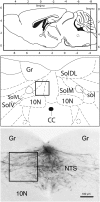Involvement of Amylin and Leptin in the Development of Projections from the Area Postrema to the Nucleus of the Solitary Tract
- PMID: 29250032
- PMCID: PMC5715394
- DOI: 10.3389/fendo.2017.00324
Involvement of Amylin and Leptin in the Development of Projections from the Area Postrema to the Nucleus of the Solitary Tract
Abstract
The area postrema (AP) and the nucleus of the solitary tract (NTS) are important hindbrain centers involved in the control of energy homeostasis. The AP mediates the anorectic action and the inhibitory effect on gastric emptying induced by the pancreatic hormone amylin. Amylin's target cells in the AP project to the NTS, an integrative relay center for enteroceptive signals. Perinatal hormonal and metabolic factors influence brain development. A postnatal surge of the adipocyte-derived hormone leptin represents a developmental signal for the maturation of projections between hypothalamic nuclei controlling energy balance. Amylin appears to promote neurogenesis in the AP in adult rats. Here, we examined whether amylin and leptin are required for the development of projections from the AP to the NTS in postnatal and adult mice by conducting neuronal tracing studies with DiI in amylin- (IAPP-/-) and leptin-deficient (ob/ob) mice. Compared to wild-type littermates, postnatal (P10) and adult (P60) IAPP-/- mice showed a significantly reduced density of AP-NTS projections. While AP projections were also reduced in postnatal (P14) ob/ob mice, AP-NTS fiber density did not differ between adult ob/ob and wild-type animals. Our findings suggest a crucial function of amylin for the maturation of neuronal brainstem pathways controlling energy balance and gastrointestinal function. The impaired postnatal development of neuronal AP-NTS projections in ob/ob mice appears to be compensated in this experimental model during later brain maturation. It remains to be elucidated whether an amylin- and leptin-dependent modulation in neuronal development translates into altered AP/NTS-mediated functions.
Keywords: energy homeostasis; hindbrain; neuronal development; neuronal programming; obesity.
Figures




Similar articles
-
The anorectic effect of a chronic peripheral infusion of amylin is abolished in area postrema/nucleus of the solitary tract (AP/NTS) lesioned rats.Int J Obes Relat Metab Disord. 2001 Jul;25(7):1005-11. doi: 10.1038/sj.ijo.0801664. Int J Obes Relat Metab Disord. 2001. PMID: 11443499
-
Lesion of the area postrema/nucleus of the solitary tract (AP/NTS) attenuates the anorectic effects of amylin and calcitonin gene-related peptide (CGRP) in rats.Peptides. 1998;19(2):309-17. doi: 10.1016/s0196-9781(97)00292-1. Peptides. 1998. PMID: 9493863
-
Amylin and Leptin: Co-Regulators of Energy Homeostasis and Neuronal Development.Trends Endocrinol Metab. 2017 Feb;28(2):153-164. doi: 10.1016/j.tem.2016.11.004. Epub 2016 Dec 6. Trends Endocrinol Metab. 2017. PMID: 27938937 Review.
-
Endogenous amylin contributes to birth of microglial cells in arcuate nucleus of hypothalamus and area postrema during fetal development.Am J Physiol Regul Integr Comp Physiol. 2019 Jun 1;316(6):R791-R801. doi: 10.1152/ajpregu.00004.2019. Epub 2019 Apr 3. Am J Physiol Regul Integr Comp Physiol. 2019. PMID: 30943041
-
Pancreatic amylin as a centrally acting satiating hormone.Curr Drug Targets. 2005 Mar;6(2):181-9. doi: 10.2174/1389450053174596. Curr Drug Targets. 2005. PMID: 15777188 Review.
Cited by
-
Neurodevelopmental Programming of Adiposity: Contributions to Obesity Risk.Endocr Rev. 2024 Mar 4;45(2):253-280. doi: 10.1210/endrev/bnad031. Endocr Rev. 2024. PMID: 37971140 Free PMC article. Review.
-
Modulating the Excitability of Olfactory Output Neurons Affects Whole-Body Metabolism.J Neurosci. 2022 Jul 27;42(30):5966-5990. doi: 10.1523/JNEUROSCI.0190-22.2022. Epub 2022 Jun 16. J Neurosci. 2022. PMID: 35710623 Free PMC article.
-
A new phase model of the spatiotemporal relationships between three circadian oscillators in the brainstem.Sci Rep. 2023 Apr 4;13(1):5480. doi: 10.1038/s41598-023-32315-y. Sci Rep. 2023. PMID: 37016055 Free PMC article.
-
The Coding Logic of Interoception.Annu Rev Physiol. 2024 Feb 12;86:301-327. doi: 10.1146/annurev-physiol-042222-023455. Epub 2023 Dec 7. Annu Rev Physiol. 2024. PMID: 38061018 Free PMC article. Review.
-
Developmental programming of hypothalamic melanocortin circuits.Exp Mol Med. 2022 Apr;54(4):403-413. doi: 10.1038/s12276-021-00625-8. Epub 2022 Apr 26. Exp Mol Med. 2022. PMID: 35474338 Free PMC article. Review.
References
Grants and funding
LinkOut - more resources
Full Text Sources
Other Literature Sources
Molecular Biology Databases
Research Materials
Miscellaneous

